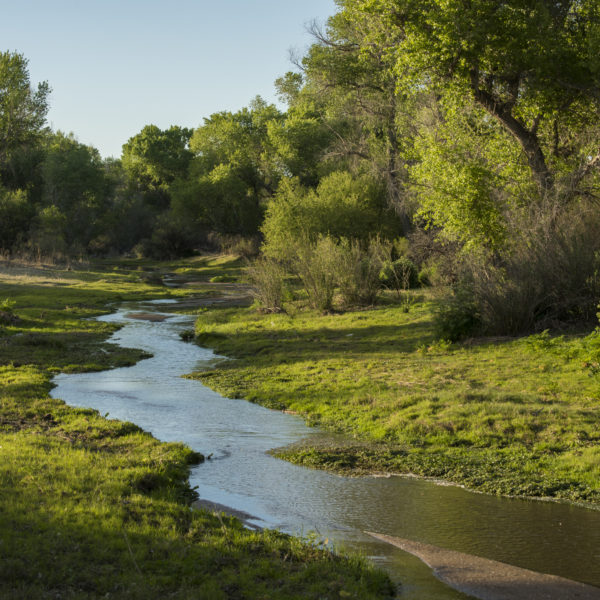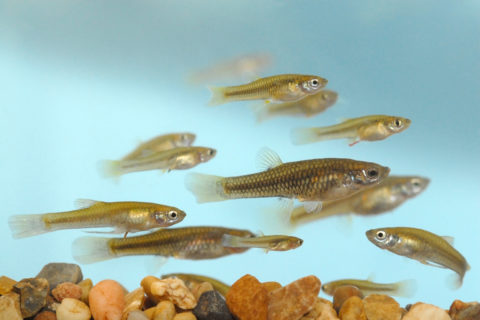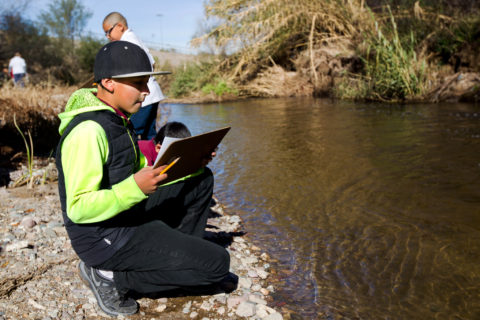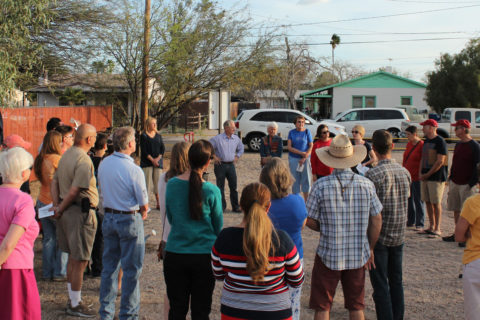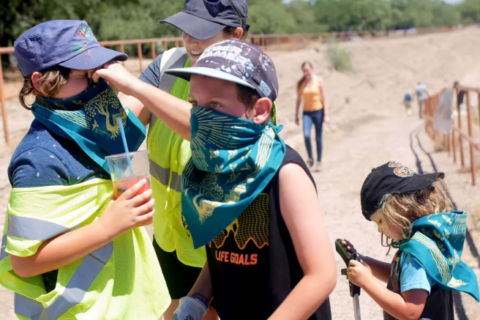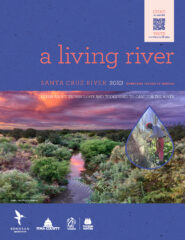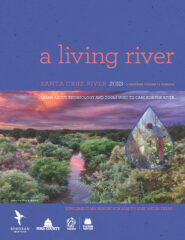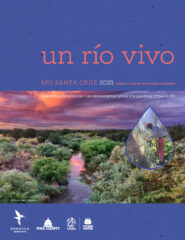Join us
Sonoran Institute is leading the continued restoration of the Santa Cruz River, our jewel in the desert, and we want everybody in our region to join us.
Whether you live in the San Rafael Valley, Ambos Nogales, the Tohono O’odham Nation, Tucson, or Marana, this is your river—if we don’t work together to protect it, it could disappear.
A Living River
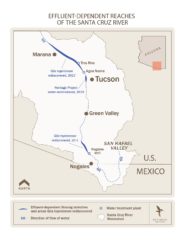
The Santa Cruz River and the aquifer lying beneath it have provided life-sustaining water to humans for more than 12,000 years. Climate aridification and a century of overuse had largely depleted the aquifer of groundwater and dried up the Santa Cruz River. Since the 1970s, however, wastewater effluent has been the source of water in two perennially flowing stretches of the river and was of exceedingly poor quality.
Fortunately, recent river revitalization initiatives have prompted these wastewater treatment plants to make massive technological upgrades, resulting in the return of clean water—bringing with it the plants and animals that depend on it. The Santa Cruz River can continue to be restored to the vitality of its past to once again support the people, agriculture, and nature of our region. Through our dedication and your support, the river will be a ribbon of life again—refreshing and welcoming in an arid landscape.
Our Opportunity
The introduction of effluent (highly treated wastewater) from facilities in Santa Cruz and Pima counties provides approximately 38 miles of perennial flows, including the Heritage Project reach—created in 2019—that flows through downtown Tucson. Upgrades made in the last decade have improved water quality, creating conditions for the return of native fish (including the endangered Gila topminnow), birds, reptiles, and vegetation, all while affording people recreational activities along the river corridor. These collective efforts have produced beautiful flowing sections, which point the way to our bright future.
Sonoran Institute has over 30 years of experience working on the Santa Cruz River in the U.S. and Mexico. The new and increasing releases of highly treated effluent to the river not only restore the natural river ecosystem, but offer much needed community and economic benefits that are equally integral to our vision. We see restoring the river as a means to fulfill our collective goals of instilling community pride, creating a lasting connection with our rare desert environment, and as an economic asset.
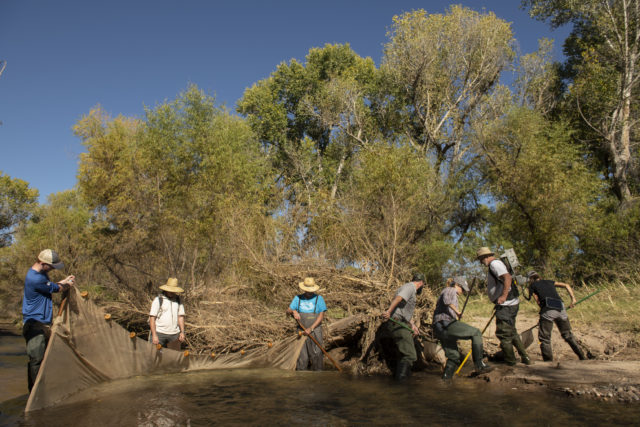
Becoming an Urban Wildlife Refuge
The Santa Cruz River, a symbol of resilience and restoration, faces renewed threats as it struggles to maintain its recent progress. Today, American Rivers announces the inclusion of the Santa Cruz River in its annual list of America’s Most Endangered Rivers®. The Santa Cruz River was once a desert oasis that was dried up and polluted for decades — and only recently is it coming back to life. Climate change and water scarcity threaten progress to ensure clean, flowing water in the river. Further, rollbacks to clean water protections at the federal level could add new challenges to the health of the watershed longer term. American Rivers and its partners called on the U.S. Fish and Wildlife Service to establish an Urban National Wildlife Refuge to ensure this river remains a community treasure.
Wastewater facilities provide approximately 35 miles of perennial flows — improved water quality, and native fish, birds, reptiles, vegetation, and people are all returning to the river. These gains are seen in beautiful flowing sections in Santa Cruz County that support a rare cottonwood–willow forest within the unique and extraordinary Sonoran Desert, as well as a vibrant urban corridor through the City of Tucson. The river has historically provided for strong communities of ranchers and farmers, and now contributes to the success of the Tumacácori National Historical Park, the de Anza Trail, and Sweetwater Wetlands as important recreation and birding sites. The growing tourism and service industries complement those still working the land and add to prosperity for the region.
While binational, state, local, private, and academic institutions have put time and money into reconnecting people to the Santa Cruz, the river’s recovery remains tenuous. The greatest challenge to the Santa Cruz River today is maintaining the water that remains and avoiding backsliding on the progress made over the past decade.
Sonoran Institute, in partnership with The Wilderness Society, has been working to establish a Santa Cruz River Urban National Wildlife Refuge. The purpose is to celebrate the river’s diverse and rich cultural heritage, honor the revitalized river, increase access to nature, and protect this crucial greenspace.
The Santa Cruz River has provided life-sustaining water to humans for more than 12,000 years — including some of the oldest communities in North America. The Tohono Oʼodham Nation has stewarded these lands and waters since time immemorial, and both the Tohono O’odham Nation and Pascua Yaqui Tribe continue to live in the area today.
The annual America’s Most Endangered Rivers report is a list of rivers at a crossroads, where key decisions in the coming months will determine the rivers’ fates. Over the years, the report has helped spur many successes including the removal of outdated dams, the protection of rivers with Wild and Scenic designations, and the prevention of harmful development and pollution
LEARN MORE
Achieving Our Vision
Sonoran Institute’s unique history of collaboration and working at the nexus of commerce, community, and conservation make the vision of a vibrant, flowing Santa Cruz River possible. We continually work to create opportunities for children to play and learn at the river and for locals and visitors to bike, walk, and enjoy the Santa Cruz—activities that increase health and social connection. We will work with community groups to see how the river can meet their needs. A clean, shady riverbank can be the perfect space for outdoor classes, pop-up vintage sales, small concerts, and festivals. Volunteer clean-up days and tree plantings introduce neighbors to one another. As people reconnect to the river, a widespread awareness of its value will create a constituency for support for policies that link the condition of the Santa Cruz River to community health and prosperity.
Your Support
We’ve spent 30 years working on the Santa Cruz River, on both sides of the border. We’re in it for the long haul. Like you, we dream of a healthy, more prosperous community. Now is the best chance to turn the Santa Cruz River into a strong, beautiful and resilient source of pride, powerful enough to drive a regional economy.
Every person in our region needs to play a role. We encourage everybody to visit the river, make a connection, and get involved. Donate today. Spread the word and become an advocate for this river on the rebound. The ribbon of life that has sustained our region for millennia can flow again with your support.

